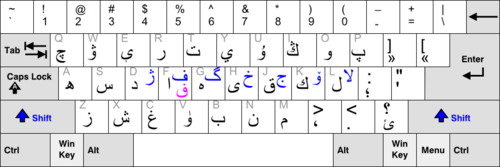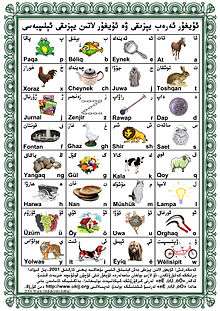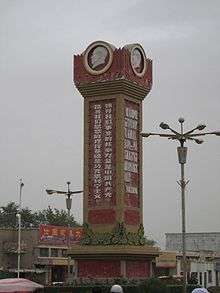Uyghur alphabets
Uyghur is a Turkic language with a long literary tradition spoken in Xinjiang, China by the Uyghurs. Today, the Uyghur Arabic alphabet is the official writing system used for Uyghur in Xinjiang. Whereas other alphabets like the Uyghur Latin alphabet and Uyghur Cyrillic alphabets are still in use outside China, especially Central Asia.
History
Old Uyghur and Modern Uyghur
The Old Uyghur language and Modern Uyghur are distinct Turkic languages and are not different stages of the same language. The Old Uyghur language is ancestral to Western Yugur, while modern Uyghur is descended from one of the Karluk languages.
Old Uyghur alphabets
5th to 18th century
In the 5th century Old Uyghur was written for the first time using the Sogdian alphabet. This fell out of use during the 10th century, when it evolved into the Old Uyghur alphabet, although it was taken into use again between the 15th and 16th century. While the Sogdian alphabet was still in use, it was written with the Old Turkic alphabet from the 6th-9th centuries.
The Old Uyghur language evolved into the modern Western Yugur, and remained in use until the 18th century among the Yugur.
Modern Uyghur alphabets
10th century to 19th century
An Arabic alphabet introduced along with Islam in the 10th century to the Karluk Kara Khanids, which evolved into the modern day Uyghur Arabic alphabet.
The Arabic-derived alphabet taken into use first came to be the so-called Chagatai script, which was used for writing the Chagatai language and the Turki (modern Uyghur) language, but fell out of use in the early 1920s, when the Uyghur-speaking areas variously became a part of, or under the influence of, the Soviet Union.[1]
The Chagatai alphabet was known as Ⱪona Yeziⱪ ("Old script") (Kona Yëziq).
The Syriac alphabet has also been used for writing Old Uyghur at some time between the 5th century and 19th century.[2]
20th to 21st century

The writing of Uyghur saw many changes during the 20th century mostly to do with political decisions, both from the Soviet and Chinese side. The Soviet Union first tried to romanize the writing of the language, but soon after decided to promote a Cyrillic script during the late 1920s known as the Uyghur Cyrillic alphabet, fearing that a romanization of the language would strengthen the relationship of the Uyghurs with other Turkic peoples.
With the establishment of the People's Republic of China in 1949, the promotion of a Cyrillic script began, but when the tensions between the Soviet Union and China grew during the late 1950s, the Chinese devised a new alphabet based upon Pinyin and Cyrillic (with some letters borrowed from the Soviet's Uniform Turkic Alphabet – a Cyrillic-influenced Latin alphabet, with Latin letters like Ə, Ƣ, Ⱨ, Ɵ, etc.), which is known as the Uyghur New Script and promoted this instead, and which soon became the official alphabet of usage for almost 10 years.
In 1982 Uyghur new script was abolished, the Arabic alphabet was reinstated in a modified form as the Uyghur Arabic alphabet.[3] However, due to the increasing importance of information technology, there have been requests for a Latin alphabet, for easier use on computers. This resulted in five conferences between 2000 and 2001, where a Latin-derived auxiliary alphabet was devised known as the Uyghur Latin alphabet.[4]
Present situation

Uyghur Ereb Yëziqi we Uyghur Latin alphabet sëlishturma ëlipbesi.
Today, the Uyghur language is written using four different alphabets, which are:
- UEY, the Uyghur Arabic alphabet, the only official alphabet in the Xinjiang province of China and is widely used in government, social media and in everyday life;
- ULY: the Uyghur Latin alphabet was introduced in 2008 and is to be used solely in computer-related fields as an ancillary writing system, but nowadays it is widely used outside China, especially in western countries;
- UKY, the Uyghur Cyrillic alphabet is mostly used by Uyghurs living in Central Asian countries, especially in Kazakhstan;
- UYY: the older mixed Uyghur New Script (also called Pinyin Yeziⱪi or UPNY), this alphabet is also Latin-based, but now most people use ULY instead of UYY.
In the table below, the alphabets are shown side-by-side for comparison, together with phonetic transcription in the International Phonetic Alphabet. It is only grouped by phonemic proximity; each alphabet has its own sorting order. Some letter forms that are used for words borrowed from other languages (notably proper names), or kept occasionally from older orthographic conventions, are shown in parentheses.
|
| ||||||||||||||||||||||||||||||||||||||||||||||||||||||||||||||||||||||||||||||||||||||||||||||||||||||||||||||||||||||||||||||||||||||||||||||||||||||||||||||||||||||||||||||||||||||||||||||

As it can be seen, the Uyghur Arabic alphabet, Uyghur New Script and Uyghur Latin alphabet each have a total of 32 letters (including one digraph for ⟨ng⟩ in the two Latin-based alphabets, plus four digraphs in ULY). Differences may still exist in texts using the newer Latin orthography, where the standard choice of ⟨ë⟩ is sometimes written ⟨é⟩ instead, with the acute accent instead of the standardized diaeresis: this should not make any difference in Uyghur.
The Uyghur Cyrillic alphabet has three additional letters, the Cyrillic soft letters/ligatures ⟨ё⟩, ⟨ю⟩, and ⟨я⟩, representing /je/, /jo/, and /ja/, respectively, which are written with an independent consonant and vowel in the other alphabets. Some words may still use the Cyrillic soft sign. Also, loanwords of Russian origin are often spelled as they are in Russian, and thus not adapted to Uyghur orthography.[5]
Another notable feature of the Uyghur New Script is the use of the letter ⟨ƣ⟩ to represent /ʁ/ (sometimes incorrectly rendered as /ɣ/). This letter has erroneously been named LATIN LETTER OI in Unicode, although it is correctly referred to as gha[6] and replaced by the digraph ⟨gh⟩ in the newer Uyghur Latin alphabet.
In the Uyghur Latin alphabet, only the ISO basic Latin alphabet is needed, with the common diaeresis (umlaut) being the only diacritic added above vowels, which is also supported by many fonts and encoding standards. The letter ⟨c⟩ is only used in the ⟨ch⟩ digraph, and the letter ⟨v⟩ is normally not used, except in loanwords where the difference between /v/ and /w/ is needed for correct pronunciation and distinctions. The /ʒ/ may be interchangeably represented in two ways, either as ⟨zh⟩ or as ⟨j⟩, although the latter is also used for /dʒ/ (which is normally inferred contextually in Uyghur, and only needed as a separate letter for loanwords needing the distinction). In the Arabic and Cyrillic orthographies, the distinction of /dʒ/ is only seen as a graphic variant of /ʒ/, reducing the Latin alphabet to only 31 effective letters. This variation is due to several opposing arguments, and therefore it was accepted that both are acceptable, as long as no semantic distinction is necessary.[7]
One of the major differences among the four alphabets is the rules of when the glottal stop /ʔ/ is written. In Uyghur Arabic alphabet, it is consistently written, using the hamza on a tooth ⟨ﺋ⟩, as well as at the beginning of words. However, in that case, that Arabic letter is not considered as a separate letter in Uyghur, but as the holder of the Arabic vowel that follows, without pronouncing the glottal stop itself, but only a hiatus (separating vowels instead of creating diphthongs, the only diphthongs being those formed with /j/ and /w/, viewed as consonants starting a separate syllable in Uyghur). However, some words of Arabic origin won't always be using this tool (this transforms the Arabic script into a true alphabet with plain vowels in Uyghur, and not an abjad).
In the Uyghur Cyrillic alphabet and Uyghur New Script, the glottal stop was only written word-medially, using an apostrophe (⟨’⟩), but it is not required and thus not very consistent.
And finally, in the Uyghur Latin alphabet, the glottal stop is written between consonants and vowels (also using an apostrophe, but consistently), and also to separate ⟨gh⟩, ⟨ng⟩, ⟨sh⟩, and ⟨zh⟩ when these represent two phonemes and not digraphs for single consonants; for instance, the word bashlan’ghuch, pronounced /bɑʃlɑnʁutʃ/ and meaning beginning, which would have been pronounced /bɑʃlɑŋhutʃ/ without the apostrophe.
Example
Below is the same text in Uyghur, but written using each of the four alphabets in common use today.
The text is taken from the first article of the Universal Declaration of Human Rights.[2]
| Arabic alphabet (UEY): | ھەممە ئادەم تۇغۇلۇشىدىنلا ئەركىن، ئىززەت۔ھۆرمەت ۋە ھوقۇقتا باب۔باراۋەر بولۇپ تۇغۇلغان. ئۇلار ئەقىلگە ۋە ۋىجدانغا ئىگە ھەمدە بىر۔بىرىگە قېرىنداشلىق مۇناسىۋىتىگە خاس روھ بىلەن مۇئامىلە قىلىشى كېرەك. |
|---|---|
| Cyrillic alphabet (UKY): | Һәммә адәм туғулушидинла әркин, иззәт-һөрмәт вә һоқуқта баббаравәр болуп туғулған. Улар әқилгә вә виҗданға игә һәмдә бир-биригә қериндашлиқ мунасивитигә хас роһ билән муамилә қилиши керәк. |
| Former Pinyin-based alphabet (UYY): | Ⱨəmmə adəm tuƣuluxidinla ərkin, izzət-ⱨɵrmət wə ⱨoⱪuⱪta babbarawər bolup tuƣulƣan. Ular əⱪilgə wə wijdanƣa igə ⱨəmdə bir-birigə ⱪerindaxliⱪ munasiwitigə has roⱨ bilən mu’amilə ⱪilixi kerək. |
| Uyghur Latin alphabet (ULY): | Hemme adem tughulushidinla erkin, izzet-hörmet we hoquqta babbarawer bolup tughulghan. Ular eqilge we wijdan'gha ige hemde bir-birige qërindashliq munasiwitige xas roh bilen muamile qilishi kërek. |
| English: | All human beings are born free and equal in dignity and rights. They are endowed with reason and conscience and should act towards one another in a spirit of brotherhood. |
References
Notes
- Duval & Janbaz 2006, pp. 1–2
- Omniglot: Uyghur
- XUAR Government Document No. XH-1982-283
- Duval & Janbaz 2006, pp. 2–5
- Hahn 1991, p. 102
- Some examples of LATIN LETTER OI (gha) (U+01A2, U+01A3) in Tatar and Uighur printing, with remarks on the recommended glyphs.
- Duval & Janbaz 2006, p. 11
General
- Duval, Jean Rahman; Janbaz, Waris Abdukerim (2006), An Introduction to Latin-Script Uyghur (PDF), Salt Lake City: University of Utah
- Hahn, Reinhard F. (1991), Spoken Uyghur, London and Seattle: University of Washington Press, ISBN 978-0-295-98651-7
External links
- A JavaScript-based web tool for converting among multiple Uyghur scripts
- Web tool for converting between Uyghur alphabets
- Also a web tool for converting between Uyghur alphabets
- an open-source python program for converting between Uyghur alphabets
- About Latin Script Uyghur (originally: Uyghur Computer Writing -- UKY)
- How can I write "Öö Üü ëë" on my English keyboard?